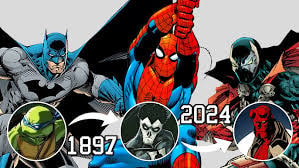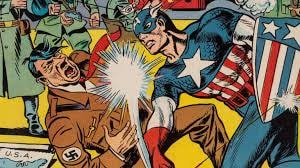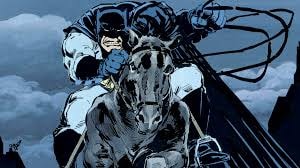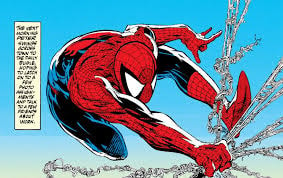
Comic Art—From Panels to Masterpieces
Comic books aren’t just stories—they’re a visual journey. Every bold line, splash of colour, and dramatic panel layout tells a story as much as the words on the page. But comic art didn’t always look like the stunning, hyper-detailed masterpieces we see today.
Over the decades, comic art has undergone a spectacular transformation, reflecting changes in culture, technology, and the artistic vision of creators. From the patriotic hues of the Golden Age to the gritty realism of the Bronze Age, each era of comic art holds a mirror to its time.
In this article, we’ll dive into the evolution of comic art, exploring the trends, styles, and trailblazing artists who’ve shaped the industry. Whether you’re a die-hard collector or just dipping your toes into the world of comics, get ready for an eye-popping journey through the decades.

The Golden Age (1930s–1950s): Bold Beginnings
The Golden Age of comics didn’t just introduce us to superheroes—it introduced a distinct style of art that became the foundation of the industry. Back then, comic art was more about functionality than flair, but that doesn’t mean it wasn’t iconic in its own right.
Art Characteristics
-
Simple Lines and Bright Colours: Printing technology of the time was limited, so artists relied on bold outlines and primary colours to make characters stand out on newsprint. These straightforward visuals became a hallmark of early superhero comics.
-
Patriotic Themes: During World War II, characters like Captain America and Wonder Woman sported red, white, and blue costumes, embodying the era's spirit of hope and resilience.
Notable Artists and Their Impact
-
Joe Shuster: Co-creator of Superman, Shuster’s clean, almost minimalist art style defined what a superhero should look like: strong, bold, and larger than life.
-
Bob Kane and Bill Finger: The team behind Batman brought a touch of noir to the Golden Age, using shadows and dramatic poses to reflect Gotham’s gritty streets.
-
Jack Kirby: Even in the Golden Age, Kirby’s dynamic compositions hinted at the explosive style that would make him a legend in later decades.
The Cultural Influence
The Golden Age wasn’t just about entertainment—it was about escapism. As the world faced the Great Depression and World War II, these brightly coloured heroes became symbols of hope and justice. The art style, while simple, was packed with optimism and energy, inspiring generations of artists to come.
The Silver Age (1950s–1970s): Dynamic and Experimental
As comics moved into the Silver Age, the art evolved to match the growing complexity of storytelling. Gone were the simple lines and bold colours of the Golden Age; the Silver Age brought a burst of energy, creativity, and emotional depth to the panels.
Art Characteristics
-
Dramatic Poses and Facial Expressions: Characters became more expressive, with exaggerated poses and detailed emotions that reflected the personal struggles woven into the stories.
-
Innovative Layouts: Artists started experimenting with dynamic panel structures, breaking away from rigid grids to create a sense of movement and action.
-
Vivid Colours: Improved printing technology allowed for a wider palette, making characters like Spider-Man and the Fantastic Four pop off the page.
Notable Artists and Their Impact
-
Jack Kirby: The “King of Comics” dominated the Silver Age, creating visually stunning cosmic adventures in titles like Fantastic Four and Thor. His bold, explosive style—packed with “Kirby Krackle”—redefined action in comic art.
-
Steve Ditko: Ditko’s work on Spider-Man and Doctor Strange introduced intricate, surreal visuals that expanded the boundaries of what comic art could achieve.
-
Carmine Infantino: Known for his work on The Flash, Infantino’s sleek designs and fluid motion gave superhero comics a modern edge.
The Cultural Influence
The Silver Age was a time of optimism and exploration. With the space race dominating headlines, comic art reflected humanity’s fascination with the cosmos. Characters were depicted with a sense of wonder and discovery, mirroring the era’s scientific advancements and cultural shifts.
The art wasn’t just pretty—it was purposeful, drawing readers into more nuanced narratives while cementing superheroes as cultural icons.

The Bronze Age (1970s–1985): Grit and Realism
The Bronze Age of comics marked a significant shift in both storytelling and art. Gone were the days of pure heroics and bright optimism. Instead, the art reflected darker themes and more grounded characters, mirroring the social and political turbulence of the time.
Art Characteristics
-
Realistic Details: Artists focused on anatomical accuracy and lifelike proportions, making superheroes feel more human.
-
Moodier Colours: The vibrant hues of the Silver Age were toned down, replaced with deeper, darker tones that suited the grittier narratives.
-
Cinematic Composition: Panels were arranged with a storytelling flair, often mimicking camera angles and dramatic lighting found in movies.
Notable Artists and Their Impact
-
Neal Adams: Adams brought unparalleled realism to Batman, Green Lantern/Green Arrow, and other titles. His expressive faces and dynamic poses set a new standard for comic art.
-
Frank Miller: Although he’d become a bigger name in the Modern Age, Miller’s early work in the Bronze Age, such as on Daredevil, brought a noir sensibility to comic visuals.
-
John Romita Sr.: Known for his work on The Amazing Spider-Man, Romita’s clean yet emotional style bridged the gap between the playful Silver Age and the grittier Bronze Age.
The Cultural Influence
The Bronze Age art mirrored the societal challenges of the time, from the Vietnam War to civil rights movements. Comics tackled real-world issues like drug addiction and corruption, and the art followed suit, becoming more reflective and somber.
Readers saw their heroes less as untouchable icons and more as relatable figures facing genuine struggles. This shift made the Bronze Age a turning point for the industry, and its art remains a favourite among collectors who value authenticity and depth.

The Modern Age (1985–2000s): High Detail and Bold Experimentation
The Modern Age of comics took the foundation laid by previous eras and pushed it to new heights. With advancements in printing and the growing popularity of independent publishers, comic art became a playground for bold experiments and hyper-detailed visuals.
Art Characteristics
-
Intricate Detailing: From muscles and costumes to cityscapes and backgrounds, everything was drawn with an almost obsessive level of detail.
-
Edgier Styles: Artists embraced darker, more stylised visuals, reflecting the grittier tone of the stories. Think jagged edges, heavy shadows, and dramatic contrasts.
-
Digital Colouring: The introduction of computer-based colouring gave comics a polished, high-gloss look that made characters leap off the page.
Notable Artists and Their Impact
-
Todd McFarlane: Best known for his work on Spider-Man and as the creator of Spawn, McFarlane’s art was all about exaggeration—dynamic poses, intricate webbing, and larger-than-life designs.
-
Jim Lee: A fan favourite for his work on X-Men, Lee brought a sleek, cinematic quality to his art, making every page feel like a blockbuster scene.
-
Frank Miller: With The Dark Knight Returns and Sin City, Miller pioneered a gritty, noir-inspired art style that became synonymous with darker, more mature storytelling.
The Rise of Indie Comics
While Marvel and DC dominated the mainstream, independent publishers like Image Comics, Dark Horse, and Vertigo ushered in unique, unconventional art styles. Series like Sandman (by Neil Gaiman and various artists) and Hellboy (by Mike Mignola) proved that comics could be both high art and cutting-edge storytelling.
The Cultural Influence
The Modern Age was defined by its rebellion against tradition. Artists weren’t afraid to break the rules, blending genres, experimenting with panel layouts, and pushing the boundaries of what comic art could convey. This period also saw a shift toward more adult themes, as comics evolved from kids’ entertainment to a respected medium for all ages.
The Digital Age (2000s–Present): Hyper-Realism Meets Innovation
As technology advanced, comic art entered a new frontier—the Digital Age. Artists embraced cutting-edge tools to create hyper-realistic visuals, dynamic layouts, and even interactive experiences. This era has transformed how comics are made, consumed, and appreciated.
Art Characteristics
-
Hyper-Realism: Digital tools allow for intricate details, lifelike textures, and vibrant colour gradients, making characters and settings feel almost three-dimensional.
-
Multimedia Integration: Motion comics, augmented reality (AR), and webcomics bring a new layer of interactivity, blurring the lines between static art and animation.
-
Global Influences: With digital platforms, artists worldwide have brought their unique styles to the forefront, enriching the comic art landscape.
Notable Artists and Their Impact
-
Alex Ross: Known for his painterly style in works like Kingdom Come, Ross’s realistic depictions of superheroes have become iconic in the Digital Age.
-
Fiona Staples: Co-creator of Saga, Staples blends traditional and digital techniques to create a vibrant, dreamlike aesthetic.
-
Peach Momoko: A breakout star, Momoko’s ethereal, watercolour-inspired style has redefined how variant covers are viewed and valued.
The Rise of Webcomics and Digital Platforms
Platforms like Webtoon, Tapas, and ComiXology have revolutionised the way comics are published and consumed. Artists now have direct access to global audiences, breaking down barriers and diversifying the art and stories we see.
The Cultural Influence
The Digital Age has made comic art more accessible than ever. Whether it’s indie creators reaching audiences through webcomics or traditional publishers adopting digital workflows, this era has expanded the medium in ways previously unimaginable.
Comics are no longer confined to the page—they’re evolving into multimedia experiences that continue to push the boundaries of storytelling and art.
The Collector’s Perspective on Comic Art
Comic art doesn’t just tell stories—it shapes the value of the comics themselves. For collectors, the style, quality, and cultural impact of the artwork play a huge role in determining what’s worth chasing.
-
Iconic Covers: Certain covers, like The Killing Joke by Brian Bolland or Jim Lee’s X-Men #1, have become collector favourites, valued as much for their artistry as their content.
-
Art Styles and Value: Hyper-detailed art or unique stylistic approaches, like Mike Mignola’s work on Hellboy, often make issues stand out in a collection.
-
Eras of Significance: The art of the Golden and Silver Ages is particularly prized, not just for nostalgia but for its influence on modern storytelling.
For collectors, comic art isn’t just about aesthetics—it’s about history, rarity, and the emotional connection it brings to their collection.
The Ever-Evolving Canvas
Comic art isn’t just a medium—it’s a mirror, reflecting the culture, values, and imagination of its time. From the patriotic heroes of the Golden Age to the experimental styles of the Digital Age, every era has left its mark on this vibrant art form.
What makes comic art so enduring is its ability to evolve while staying true to its roots. Whether you’re flipping through the dynamic panels of a Jack Kirby classic or scrolling through a cutting-edge Webtoon, comic art remains a visual language that connects us all.
So next time you admire a comic’s artwork, remember—you’re not just looking at a story; you’re looking at decades of creativity, innovation, and passion that make this medium truly timeless.
FAQs Answered:
Why did comic art evolve over the decades?
Comic art evolved alongside cultural shifts, advancements in technology, and changing audience tastes. From the patriotic simplicity of the Golden Age to the hyper-detailed digital art of today, each era reflects the values and innovations of its time. It’s art imitating life—and sometimes vice versa!
Who are some of the most influential comic book artists?
Legends like Jack Kirby (dynamic action), Alex Ross (hyper-realistic art), and Fiona Staples (Saga’s dreamy aesthetic) have shaped how we see comic art today. Each brought their own flair, setting trends that influenced entire generations of creators.
How has technology changed comic art?
Technology has supercharged comic art. Digital tools allow for hyper-realistic colouring, precise line work, and even motion comics. Platforms like Webtoon have made comics accessible globally, giving creators new ways to tell stories. It’s like putting comics in a high-tech Batcave.
Are Golden Age comics more valuable because of their art?
Partly, yes! Golden Age comics are prized for their historical significance, but the bold, straightforward art style is a huge draw for collectors. It’s nostalgia with a side of history—who doesn’t want a piece of Superman’s earliest adventures?
What trends define modern comic art?
Modern comic art is all about experimentation and representation. From dynamic panel layouts to diverse cultural influences, today’s art pushes boundaries. Hyper-realistic styles sit alongside minimalist designs, making this era one of the most exciting yet.
References:
-
Smithsonian Magazine - How Comic Books Became an American Art Form
URL: https://www.smithsonianmag.com/ -
Comics Alliance - The Evolution of Comic Book Art Styles Over the Decades
URL: https://comicsalliance.com/ -
Marvel Comics Official Site - Timeline of Marvel Comics Artists
URL: https://www.marvel.com/ -
DC Comics Official Site - The Art Evolution of Batman Through the Ages
URL: https://www.dccomics.com/ -
Sequential Crush - Golden Age Comics and Their Impact on Modern Art Styles
URL: https://www.sequentialcrush.com/ -
The Beat - How Indie Artists Like Fiona Staples Are Changing Comics
URL: https://www.comicsbeat.com/ -
CBR (Comic Book Resources) - 10 Artists Who Changed the Face of Comic Art
URL: https://www.cbr.com/ -
Digital Art Techniques - From Pencils to Pixels: The Digital Age of Comics
URL: https://digitalartsonline.co.uk/ -
Comic Art Fans - Spotlighting Contemporary Comic Artists
URL: https://www.comicartfans.com/ -
Peach Momoko's Official Page - Revolutionizing Variant Covers
URL: https://www.peachmomoko.com/